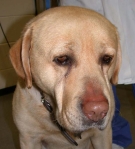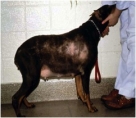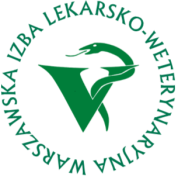What is hypothyroidism?
 Hypothyroidism is a disease in which the thyroid does not produce enough hormones to run all of the body functions at a normal rate. This can lead to many signs or symptoms, including mental and physical fatigue, weight gain, and skin or hair coat problems.
Hypothyroidism is a disease in which the thyroid does not produce enough hormones to run all of the body functions at a normal rate. This can lead to many signs or symptoms, including mental and physical fatigue, weight gain, and skin or hair coat problems.
Thyroid hormone is produced by the thyroid glands, small glands located in the neck. Thyroid hormone plays a very important role in regulating metabolism and proper functioning of the body.
Why is so important to diagnose and treat hypothyroidism?
The thyroid is responsible for the proper functioning of the heart, lungs, digestive system, skin, and brain as well as for strengthening hair and bones. It also helps the body convert calories into energy and process carbohydrates and fats.? During growth and development, thyroid hormones play an essential role in normal formation of the neurologic and skeletal systems. Puppies and kittens that develop congenital hypothyroidism show dwarfism or very stunted growth as one of the main clinical signs or symptoms.
In the adult dog or cat, thyroid hormones function affect the function and metabolism of virtually all tissues and organs in the body. Because thyroid hormone is central to many processes in the body, this means that dogs with hypothyroidism can show a wide range of signs. These signs often develop slowly and are not always very obvious to the dog owner. Sometimes the signs are confused with those of normal aging.
 Mental changes:
Mental changes:
• Lethargy
• Slow movements or reluctance to go for walks
• Increased time spent sleeping
• Lack of endurance; easily tired
• Increased sensitivity to cold
Weight changes:
• Tendency to gain weight, even on the same diet
• Inability to loss weight, even if less food is fed
Skin changes:
• Tragic facial expression, puffy face or dropping of the upper eyelids
• Increased shedding of hair
Increased shedding of hair
• Dry, coarse, thin or sparse coat
• Lack of hair regrowth, e.g. after clipping
• Dry and flaky skin (dandruff), that is not usually itchy
• Loss of hair on tail (eg, rat tail)
• Thickening of skin
• Darkening of the skin (hyperpigmentation)
• Dry and flaky or very oily skin
• Recurrent skin infections
Neurologic abnormalities (rare):
• Seizures
• Vestibular disease
• Peripheral neuropathy
 Which dogs are most likely to be affected with hypothyroidism?
Which dogs are most likely to be affected with hypothyroidism?
Virtually all breeds, including mixed breeds, can be affected by hypothyroidism. However, Labrador retrievers, Golden retrievers, Doberman pinschers, Cocker spaniels, and Boxers are among those breeds that are predisposed to develop the disease.
Dogs between 2 and 6 years of age are more commonly affected. Male and female dogs are affected in equal numbers.
How do dogs develop hypothyroidism?
About 50% of the time it is caused by a condition called lymphocytic thyroiditis, an immune-mediated condition where the body starts to create antibodies to the thyroid tissue. Other causes can be due to a cancer of the thyroid gland, a secondary condition involving the pituitary, or for unknown reasons, what we call “idiopathic.”Hypothyroidism in dogs is most commonly caused by destruction of the thyroid gland itself, which leads to the deficiency in thyroid hormone in the blood stream. Two conditions are incriminated in over 95% of cases of primary hypothyroidism in dogs. In lymphocytic thyroiditis, the body produces antibodies against the cells in the thyroid gland that destroy of the thyroid gland. With the second cause of hypothyroidism (idiopathic atrophy), cells of the thyroid gland are replaced by fat cells. The cause is not known but it thought to reflect the end-stage process of lymphocytic thyroiditis in most cases.
Signs of hypothyroidism only develop after about 75% of the thyroid gland is destroyed. This process of destruction is gradual but slowly progressive, taking from 1 to 3 years in most dogs before a diagnosis is made.
Thyroid hormone is produced by the thyroid glands, small glands located in the neck. Thyroid hormone plays a very important role in regulating metabolism and proper functioning of the body.
Why is so important to diagnose and treat hypothyroidism?
The thyroid is responsible for the proper functioning of the heart, lungs, digestive system, skin, and brain as well as for strengthening hair and bones. It also helps the body convert calories into energy and process carbohydrates and fats.? During growth and development, thyroid hormones play an essential role in normal formation of the neurologic and skeletal systems. Puppies and kittens that develop congenital hypothyroidism show dwarfism or very stunted growth as one of the main clinical signs or symptoms.
In the adult dog or cat, thyroid hormones function affect the function and metabolism of virtually all tissues and organs in the body. Because thyroid hormone is central to many processes in the body, this means that dogs with hypothyroidism can show a wide range of signs. These signs often develop slowly and are not always very obvious to the dog owner. Sometimes the signs are confused with those of normal aging.
 Mental changes:
Mental changes:• Lethargy
• Slow movements or reluctance to go for walks
• Increased time spent sleeping
• Lack of endurance; easily tired
• Increased sensitivity to cold
Weight changes:
• Tendency to gain weight, even on the same diet
• Inability to loss weight, even if less food is fed
Skin changes:
• Tragic facial expression, puffy face or dropping of the upper eyelids
•
• Dry, coarse, thin or sparse coat
• Lack of hair regrowth, e.g. after clipping
• Dry and flaky skin (dandruff), that is not usually itchy
• Loss of hair on tail (eg, rat tail)
• Thickening of skin
• Darkening of the skin (hyperpigmentation)
• Dry and flaky or very oily skin
• Recurrent skin infections
Neurologic abnormalities (rare):
• Seizures
• Vestibular disease
• Peripheral neuropathy
 Which dogs are most likely to be affected with hypothyroidism?
Which dogs are most likely to be affected with hypothyroidism?Virtually all breeds, including mixed breeds, can be affected by hypothyroidism. However, Labrador retrievers, Golden retrievers, Doberman pinschers, Cocker spaniels, and Boxers are among those breeds that are predisposed to develop the disease.
Dogs between 2 and 6 years of age are more commonly affected. Male and female dogs are affected in equal numbers.
How do dogs develop hypothyroidism?
About 50% of the time it is caused by a condition called lymphocytic thyroiditis, an immune-mediated condition where the body starts to create antibodies to the thyroid tissue. Other causes can be due to a cancer of the thyroid gland, a secondary condition involving the pituitary, or for unknown reasons, what we call “idiopathic.”Hypothyroidism in dogs is most commonly caused by destruction of the thyroid gland itself, which leads to the deficiency in thyroid hormone in the blood stream. Two conditions are incriminated in over 95% of cases of primary hypothyroidism in dogs. In lymphocytic thyroiditis, the body produces antibodies against the cells in the thyroid gland that destroy of the thyroid gland. With the second cause of hypothyroidism (idiopathic atrophy), cells of the thyroid gland are replaced by fat cells. The cause is not known but it thought to reflect the end-stage process of lymphocytic thyroiditis in most cases.
Signs of hypothyroidism only develop after about 75% of the thyroid gland is destroyed. This process of destruction is gradual but slowly progressive, taking from 1 to 3 years in most dogs before a diagnosis is made.
Źródło: animalendocrine.blogspot.com










